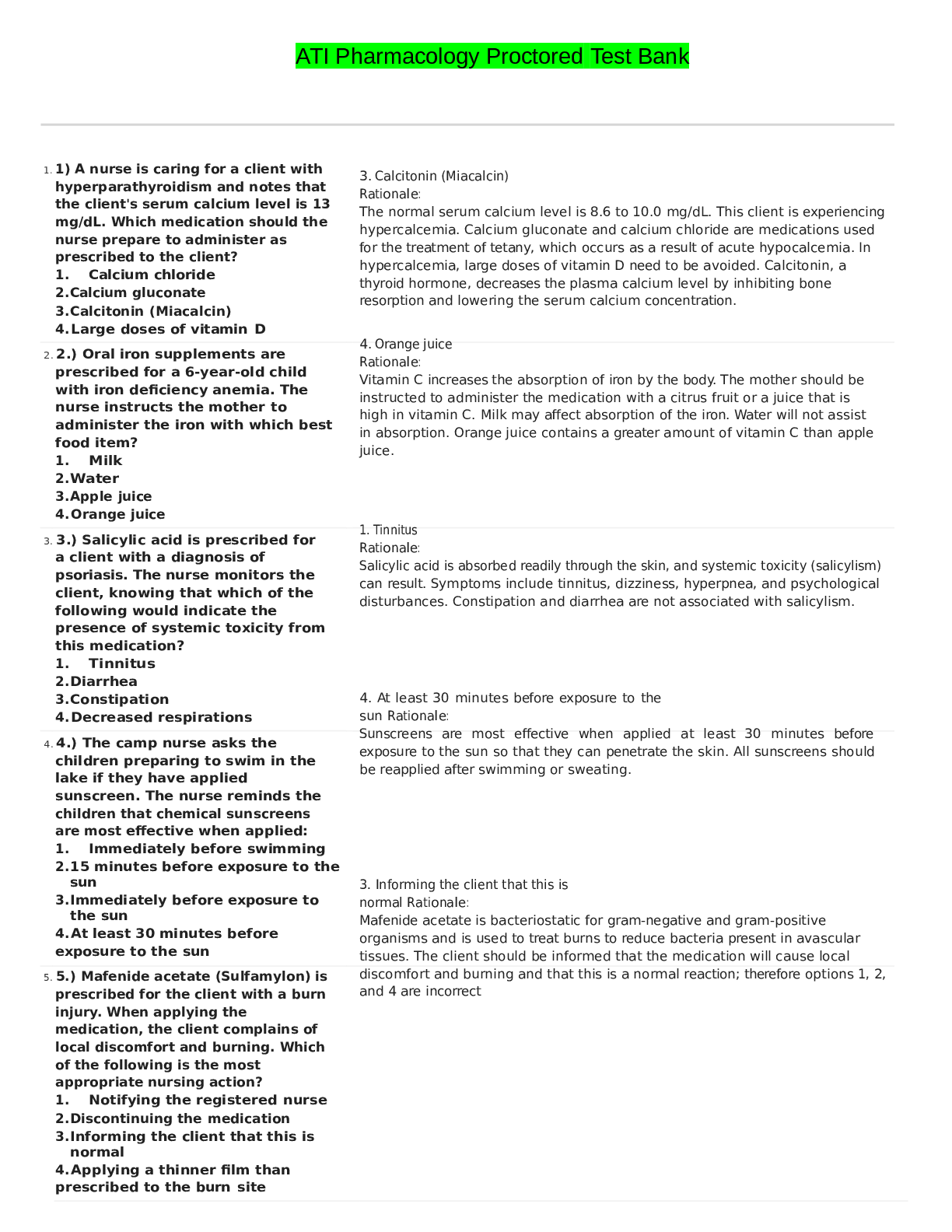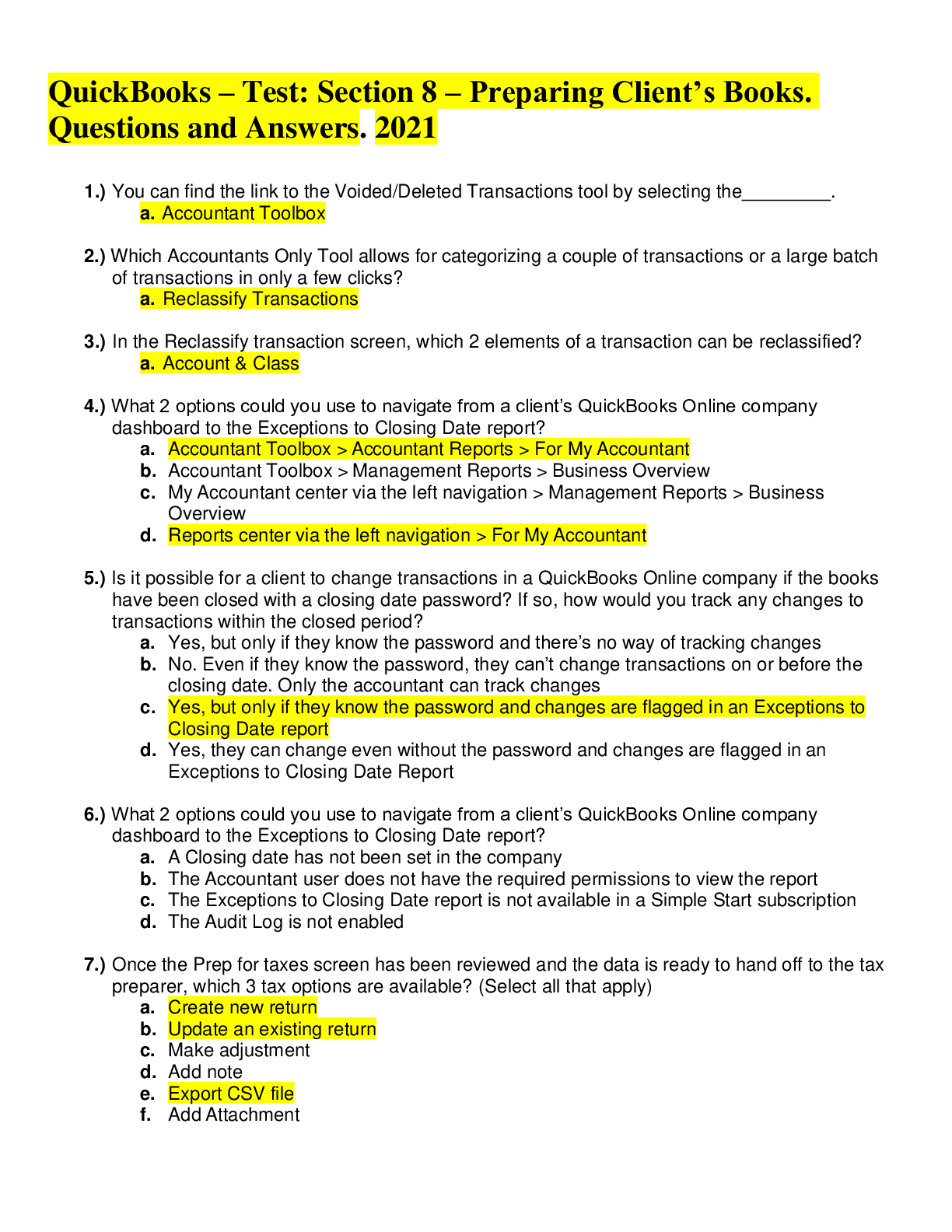Biology > QUESTIONS & ANSWERS > Purdue University: Exam 1 Key for BIOL 438. The Most Frequently Tested Questions. 250 Questions and (All)
Purdue University: Exam 1 Key for BIOL 438. The Most Frequently Tested Questions. 250 Questions and Answers explained in paragraphs and graphics.
Document Content and Description Below
Exam 1 Key for BIOL 438 1. Describe the members of the microbial world. 2. Why are microorganisms important? 3. Describe the divisions and types of microbes. Describe the types of microbial cel... ls. 4. What is the three domain system of microorganisms? Compare and contrast the three domains of microorganisms. 5. Describe the acellular infectious agents. 6. Describe the evolution of three domains of life. Describe the Last Universal Common Ancestor (LUCA). 7. What is the endosymbiotic hypothesis? 8. Describe microbial species. 9. Why are microscopes important for microbiology? 10. List and describe the types of light microscopes. 11. Describe microscope resolution. 12. What is the oil immersion objective? 13. Describe the differential interference contrast microscope (DIC). 14. Describe the confocal microscopy. 15. Why is staining specimens for microscopes important? 16. What is fixation? List and describe the types of fixation. 17. Why are dyes and simple stains important? Describe the types of dyes. 18. What is differential staining? Give examples of differential staining. 19. Describe Gram staining. 20. Describe endospore staining, capsule staining, and flagella staining. 21. Describe electron microscopy and the transmission electron microscope (TEM). 22. Describe the difference between a light and transmission electron microscope (TEM). 23. Describe the TEM specimen preparation procedures that use heavy metals. 24. List and describe the types of TEM specimen preparation methods without using heavy metals 25. Describe the scanning electron microscope 26. What is the He Ion microscope 27. Describe electron cyrotomography 28. Describe 3-D EM tomography 29. What is the “Prokaryote controversy”? 30. Describe and list the type of bacteria shapes and arrangements 31. Describe the size – shape relationship of cells. 32. What are the common features of bacterial cell organization? What are the three layers of the bacterial cell envelope? 33. Describe the bacterial plasma membrane functions 34. Describe the fluid mosaic model of the membrane structure 35. Describe the structure of the most abundant in the membrane 36. Describe bacterial lipids 37. List and describe the types of membrane proteins. 38. What are the hydrophobic, hydrophilic, and special amino acids? 39. Why must some substances pass through the membrane 40. Describe and list the types of nutrients. Give examples for each. 41. What are growth factors? Describe the classes of growth factors. 42. What are the methods for uptake of nutrients into the cell? 43. Describe passive diffusion 44. Describe facilitated diffusion and how it is different from passive diffusion. 45. What is active transport? Give the types of active transport. 46. What is group translocation? Give an example. 47. Describe the process of iron uptake for microorganisms. 48. Describe the bacterial cell wall and its functions. 49. Describe the peptidoglycan structure 50. Describe the gram positive cell walls and the structure. Don’t forget the mention and describe the components of it. 51. Describe the gram negative cell walls and the structure. Don’t forget the mention and describe the components of it. 52. Describe lipopolysaccharide (LPS). 53. Describe the mechanism of the gram stain reaction 54. Describe the hypotonic and hypertonic environments. 55. What evidence shows the protective nature of the cell wall 56. List and describe the components that can be found outside the cell wall. 57. What are the structures that are observed in bacterial cytoplasm? 58. Why are gram-positive bacteria generally more sensitive to antibiotics than gram negative? 59. What is protoplast? 60. Describe the bacterial cytoskeleton elements 61. Describe the intracytoplasmic membranes 62. Describe inclusions. What are some storage inclusions? 63. Describe microcompartments 64. Describe gas vacuoles 65. Describe magnetosomes 66. Describe bacterial ribosomes 67. Describe the bacterial nucleoid 68. Describe plasmids (“episomes”) 69. Describe external structures and list the types of external structures. 70. Describe pili and fimbriae 71. Describe flagella and the patterns of flagella distributions 72. Describe the bacterial flagella 73. Describe flagellar synthesis. 74. What are the types of bacterial motility? 75. What causes bacteria and archaea to have directed movement? 76. What is chemotaxis? 77. Describe bacterial flagellar movement 78. Describe the mechanism of flagellar movement 79. Describe swarming 80. Describe spirochete motility 81. Describe the twitching and gliding motility 82. Describe J. Adler experiments 83. Describe chemotaxis in greater detail 84. Describe endospores and its structures 85. What makes an endospore to resistant 86. Describe sporulation and its cycle 87. Describe the formation of vegetative cell 88. Describe archaea and the archaeal size, shape, and arrangement 89. Describe the archaeal cell envelopes 90. Describe the archaeal membranes and the membrane lipids 91. What are the differences between archaeal cell walls and bacterial cell walls? 92. Describe the archaeal cells and their nutrient uptake 93. Compare the archaeal and the bacterial cytoplasm 94. Describe the archaeal external structures 95. Compare and contrast bacteria and archaea Property Bacteria Archaea Plasma membrane lipids Ester-linked phospholipids and hopanoids form a lipid bilayer; some have steroids Glycerol diethers form lipid bilayers, glycerol tetra ethers form lipid monolayers Cell wall constituents Peptidoglycan is present in nearly all, some lack cell walls Very diverse, peptidoglycan is always absent, some consist of S-layer, other combine S-layer with polysaccharides or proteins or both; some lack cell walls Inclusions present YES YES Ribosome size 70S 70S Chromosome structure Most are circular, double-stranded DNA usually a single chromosomes Circular dsDNA Plasmids structure YES, circular and linear dsDNA YES, circular dsDNA External structures Flagella, fimbria(pili) Flagella, fimbria(pili), and pilus like structures Capsules of slime layers common rare 96. What are the reproductive strategies of bacteria and archaea? What are different ways they can reproduce? Describe them. 97. What is the bacterial cell cycle? What are the pathways during the cycle? 98. Describe the chromosome replication and partitioning of the bacterial cell cycle. 99. Describe cytokinesis – septation. Describe the Z-ring formation and its role in septation 100. Describe the process pf peptidoglycan synthesis. 101. What is cellular growth and determination of cell shape determined by? Describe how cocci and rods get their shape. 102. Describe the cell wall biosynthesis during cell growth in rod and spherical cells. 103. What are mesophiles and extremophiles? 104. What are the environmental factors that affect microbial growth? 105. Describe how solutes and water activity affect microbial cells and their adaptions 106. What are extremely adapted microbes to solutes and water activity? Describe them 107. What is pH? Describe the types organisms that are affected by pH? 108. Describe the pH tolerance mechanisms of microbes 109. Describe how microbes are affected by temperature and the types of temperature ranges for microbial growth. 110. Describe the temperature adaptions for microbes. 111. Describe how the oxygen concentrations affect microbes. 112. Describe the different types of microbes that are affected by the oxygen concentration. 113. Describe the strict anaerobic microbes 114. Describe the types of organisms that are affected by pressure. 115. Describe how radiation can affect microbes. 116. Where can microbial growth happen? 117. What are the modes of bacterial growth? 118. Describe the microbial growth in natural environments 119. Describe biofilms, its formation, the microorganisms, and the heterogeneity in biofilms. 120. Describe the cell to cell communication with microbial communities and quorum sensing. 121. Describe culture media and the types of media 122. Describe the isolation of pure cultures. 123. What is the most important technique invented in biotechnology? 124. Describe streak plate, spread plate, and pore plate techniques. 125. What is the importance of microbial growth on solid surfaces? 126. Only a small fraction (1%) of bacteria that are observed in natural samples can be culture in lab media. Why? 127. Describe growth and the growth curve. 128. Describe the lag phase 129. Describe the exponential phase 130. Describe balance growth 131. Describe the mathematics of growth. Describe the exponential population. What are the equations. 132. How to calculate generation time (doubling time) 133. What are the two parameters of cell growth? 134. Describe the exponential growth rate 135. Describe biomass yield 136. What is the important feature of exponential growth? 137. Describe unbalanced growth 138. Describe the stationary phase 139. What are the possible reasons for stationary phase? 140. Describe the starvation responses 141. Describe the death phase and prolonged decline in growth 142. Draw the growth curve 143. Describe how the microbial population size be measured 144. Describe the direct measurement of cell numbers 145. Describe the counting chambers 146. Describe the direct counts on membrane filters 147. Describe flow cytometry 148. Describe viable counting and its methods 149. Describe the methods of measurement of cell mass 150. Describe the continuous culture of microorganisms 151. Describe the chemostat 152. Describe the dilution rate and microbial growth 153. Describe the turbidostat 154. What is metabolism and what are its two modules? 155. Describe catabolism 156. Describe anabolism 157. What are the types of work that the cells carry out? 158. What are thermodynamics? 159. Describe the laws of thermodynamics. 160. What are the energy units? 161. Describe the free energy and it’s equation. 162. Describe chemical equilibrium and its constant. 163. Describe the standard free energy change. What is the equation? What are exergonic and endergonic reactions? 164. Describe the role of ATP in metabolism 165. Describe the phosphate transfer potential 166. Describe redox reactions 167. Describe standard redox potential 168. Describe the relationship of E0 and G 169. Describe the electron transport chain (ETC). 170. Describe electron carriers’ location and give examples 171. What three things do cells need for growth? 172. On what are the organisms classified based on? 173. Based on where organisms get carbon from, they are classified as what? 174. Based on where organisms get reducing power from, they are classified as what? 175. Based on where organisms get their energy source, they are classified as what? 176. Despite diversity of energy, electron, and carbon sources used by organisms, they all the what same basic needs? 177. Describe the “bowtie” model of metabolism 178. What are the implications of the bowtie model of metabolism? 179. What are the two distinct modes of supplying (fueling) processes? 180. What are the three common routes of the breakdown of glucose to pyruvate? 181. What is the embden-meyerhof pathway? 182. Describe the embden-meyerhof pathway 183. What are the 2 important reactions in the embden-meyerhof? 184. Summarize glycolysis - Glucose + 2ADP + 2Pi + 2NAD+ 2 pyruvate + 2ATP + 2NADH + 2H+ 185. Describe the entner-duodoroff pathway 186. Describe the pentose phosphate pathway (PPP) 187. What is the TCA? and Describe the TCA cycles. 188. What are amphibolic pathways 189. Describe both directions of the embden Meyerhof pathway 190. What are the chemical reactions of Embden-meterhof, pyruvate dehydrogenase, and TCA cycle? 191. How can these pathways from problem 190 operate continuously? 192. Describe how the electron transport chain generates the proton motive force 193. Describe the Bacterial and archaeal electron transport chains 194. Describe the electron transport chain of e. coli. 195. Describe paracoccus denitrificans 196. Why is the electron transport chain modular? 197. What is oxidative phosphorylation and the P/O ratio? 198. Describe the chemiosmotic model 199. How does the proton motive force drive ATP synthesis? Describe ATP synthase 200. Describe the ATP yield during aerobic respiration 201. What are the factors affecting ATP yield? 202. Describe anaerobic respiration 203. Describe dissimilatory nitrate reduction 204. Describe denitrification 205. Why does anaerobic respiration generate fewer ATPs/NADH than aerobic respiration 206. Describe fermentation 207. Describe the pathway of fermentation 208. Describe how ATP synthase is reversible 209. Describe the catabolism of other carbohydrates 210. What are reserve polymers 211. Describe lipid catabolism 212. Describe protein and amino acid catabolism 213. What are the two parts of photosynthesis? 214. Describe the light reactions in oxygenic photosynthesis. 215. The chlorophyll-based system properties are similar to what organism? 216. What are chlorophylls? 217. Describe the chlorophyll a 218. Describe the bacteriochlorophyll a 219. Why do different organisms have different kinds of chlorophylls absorbing light at different wavelengths? 220. Describe the accessory pigments in the light reactions in oxygenic photosynthesis? 221. What organizes the pigments? 222. Describe the antennae 223. Describe the photosystems 224. Describe the photosynthetic unit 225. Describe the oxygenic photosynthesis and what are the two electron flows? 226. Describe the noncyclic electron flow and cyclic electron flow 227. Describe the light reaction in anoxygenic photosynthesis 228. Describe heterocysts 229. Describe the archaerhodopsin-based phototrophy 230. Since both PSI and PSII can generate ATP, why are both photosystems necessary in plants? 231. Describe the nutritional types of organisms 232. Describe chemolithotrophy and the energy sources that are used. 233. Describe the reverse electron flow by chemolithotrophs 234. Describe the metabolic flexibility of chemolithotrophs 235. What is anabolism? Describe it 236. Describe the macromolecular composition of E. coli 237. What are the examples of anabolism and describe them. 238. What are the principles governing biosynthesis? 239. What are the 12 metabolites and why are they important? 240. What are the pathways that are needed for the fixation of CO2 by autotrophs? 241. Describe the Calvin Benson cycle. 242. Describe the carboxylation phase 243. Describe the reduction and regeneration phases 244. Describe CO2 fixation by the Calvin-Benson cycle - 245. What are other CO2 fixation pathways and describe them. 246. [Show More]
Last updated: 1 year ago
Preview 1 out of 49 pages
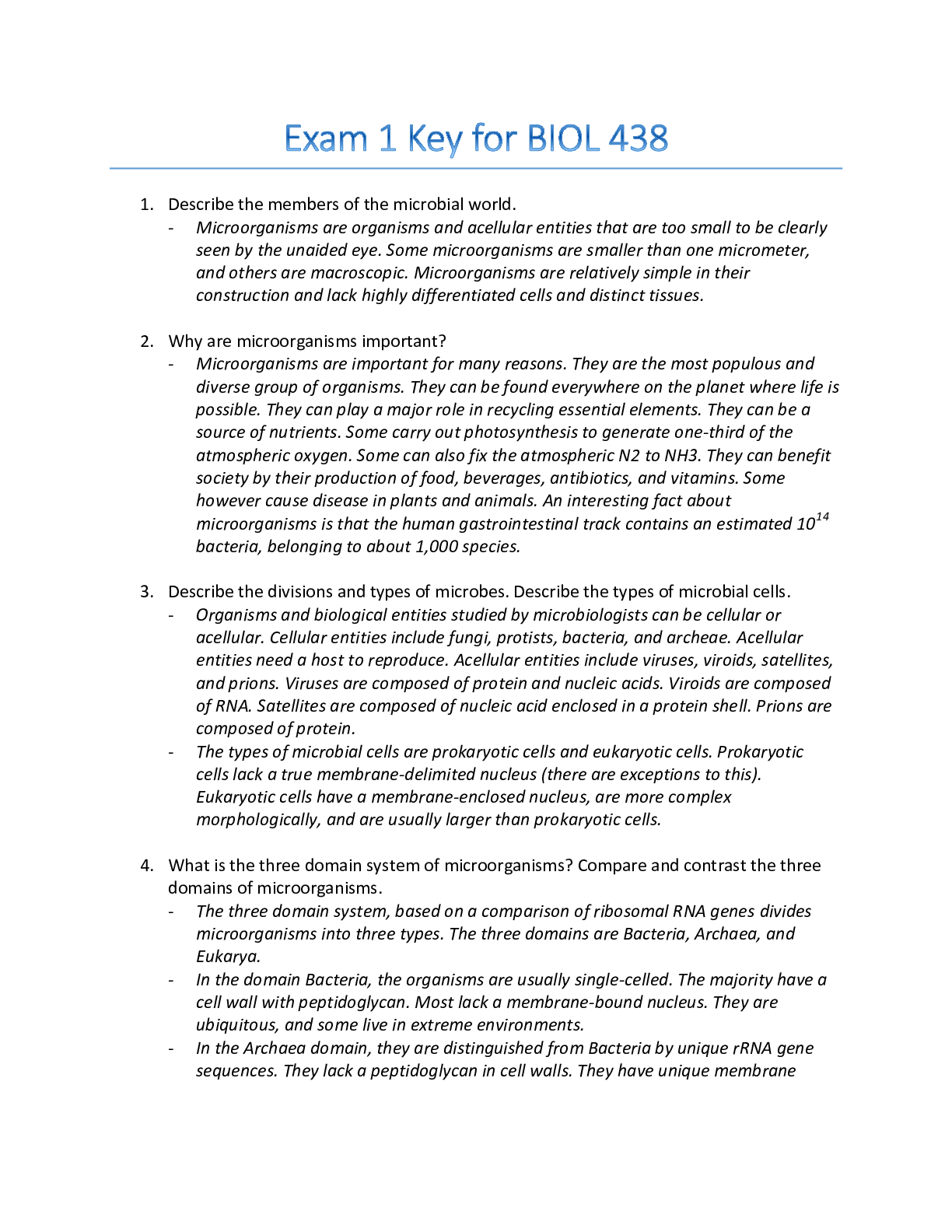
Reviews( 0 )
Document information
Connected school, study & course
About the document
Uploaded On
Sep 21, 2020
Number of pages
49
Written in
Additional information
This document has been written for:
Uploaded
Sep 21, 2020
Downloads
0
Views
76





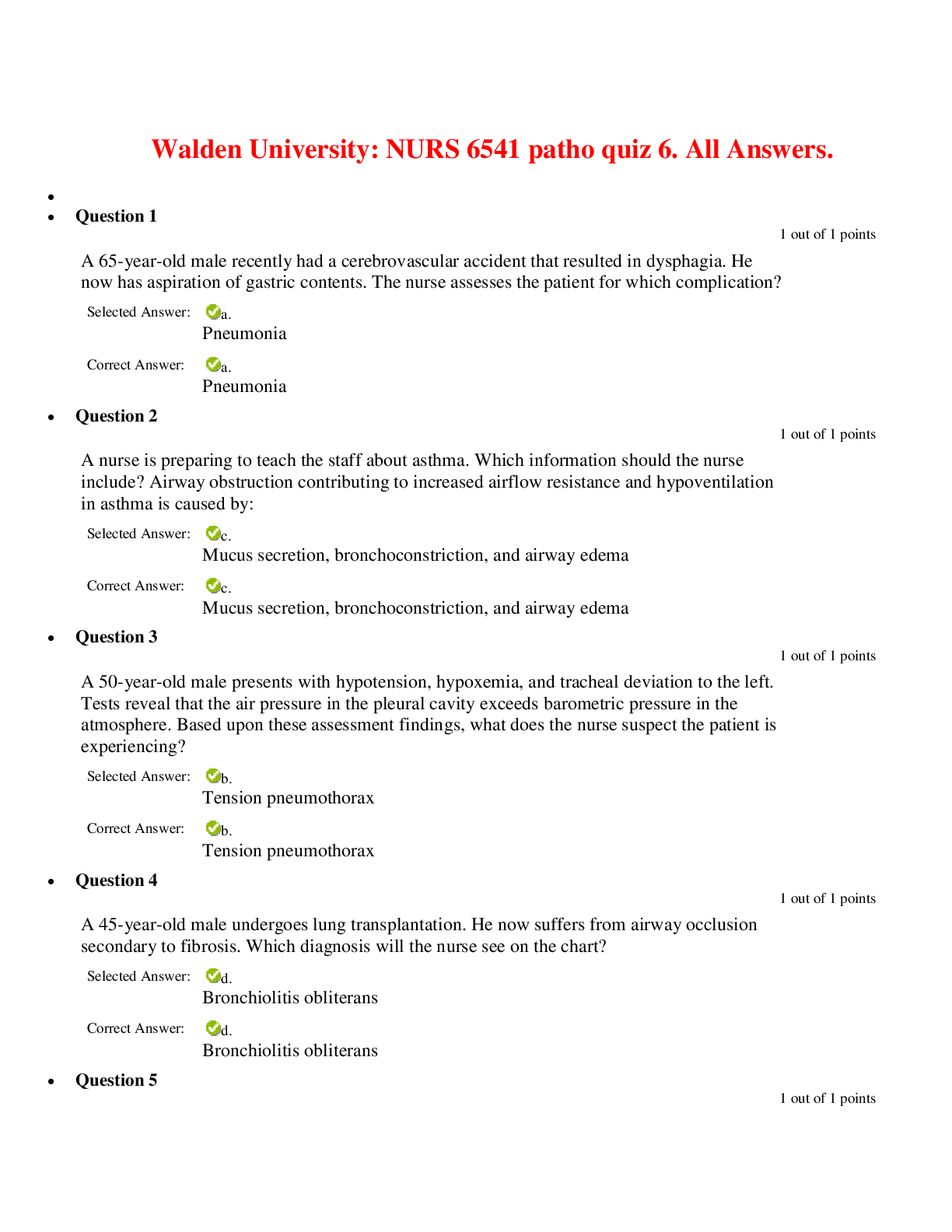





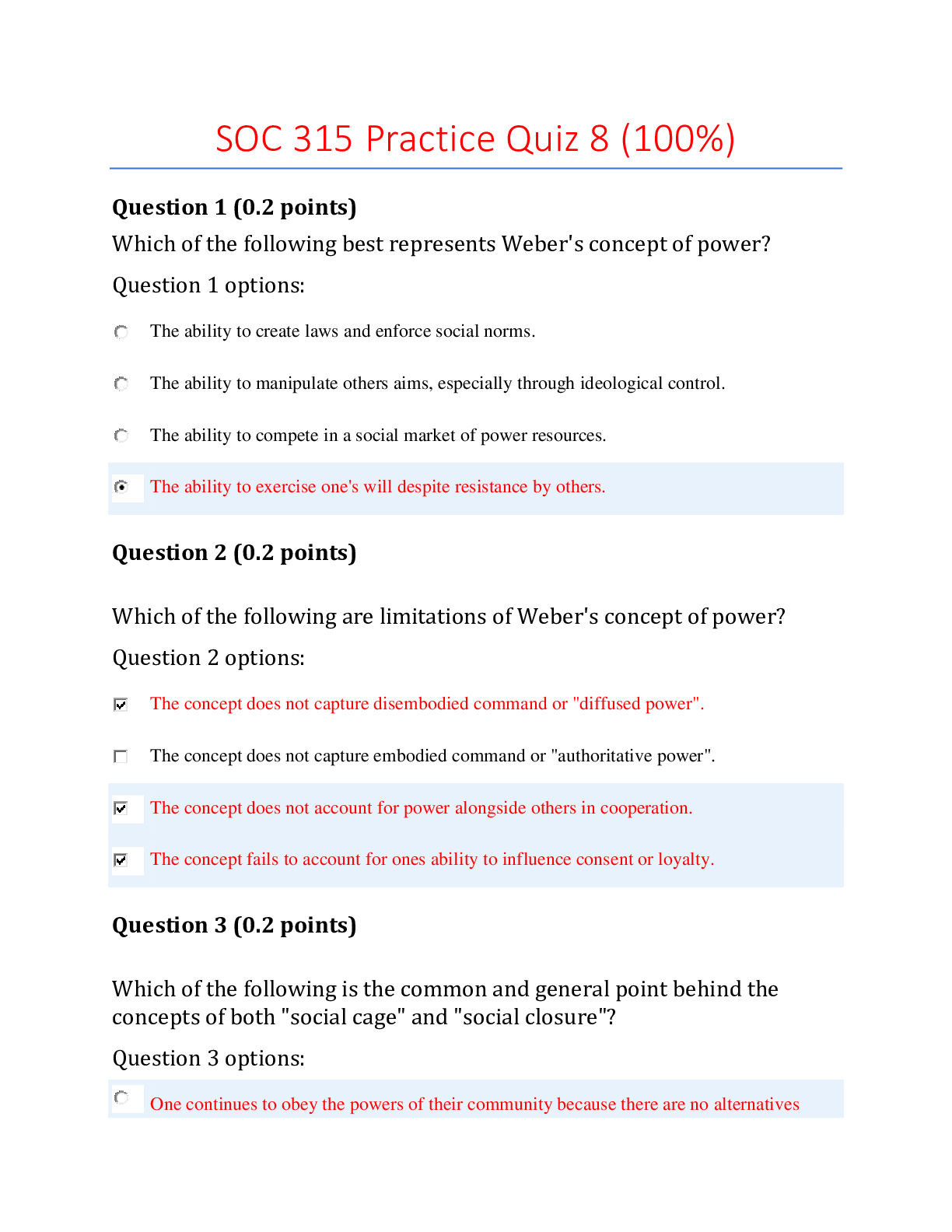
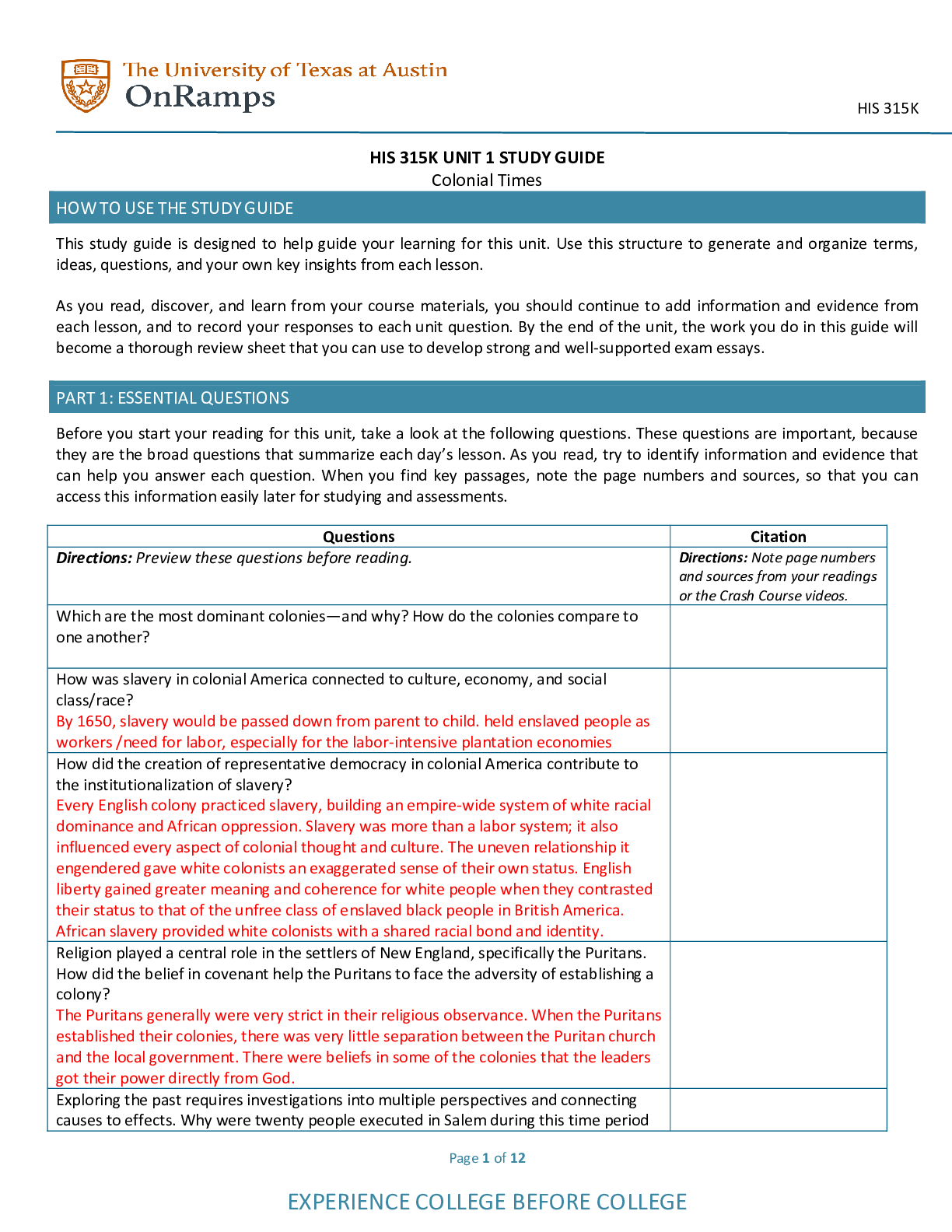
.png)

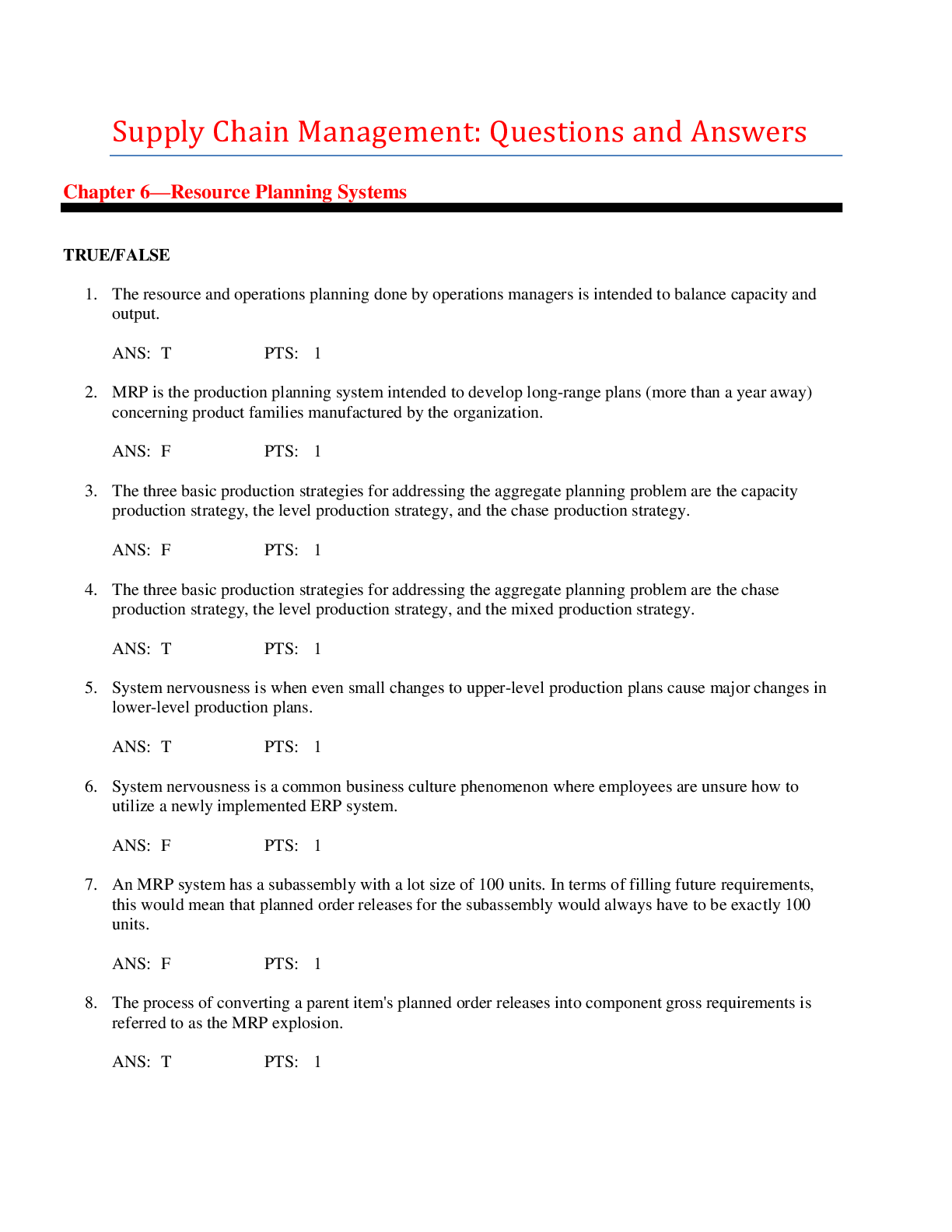
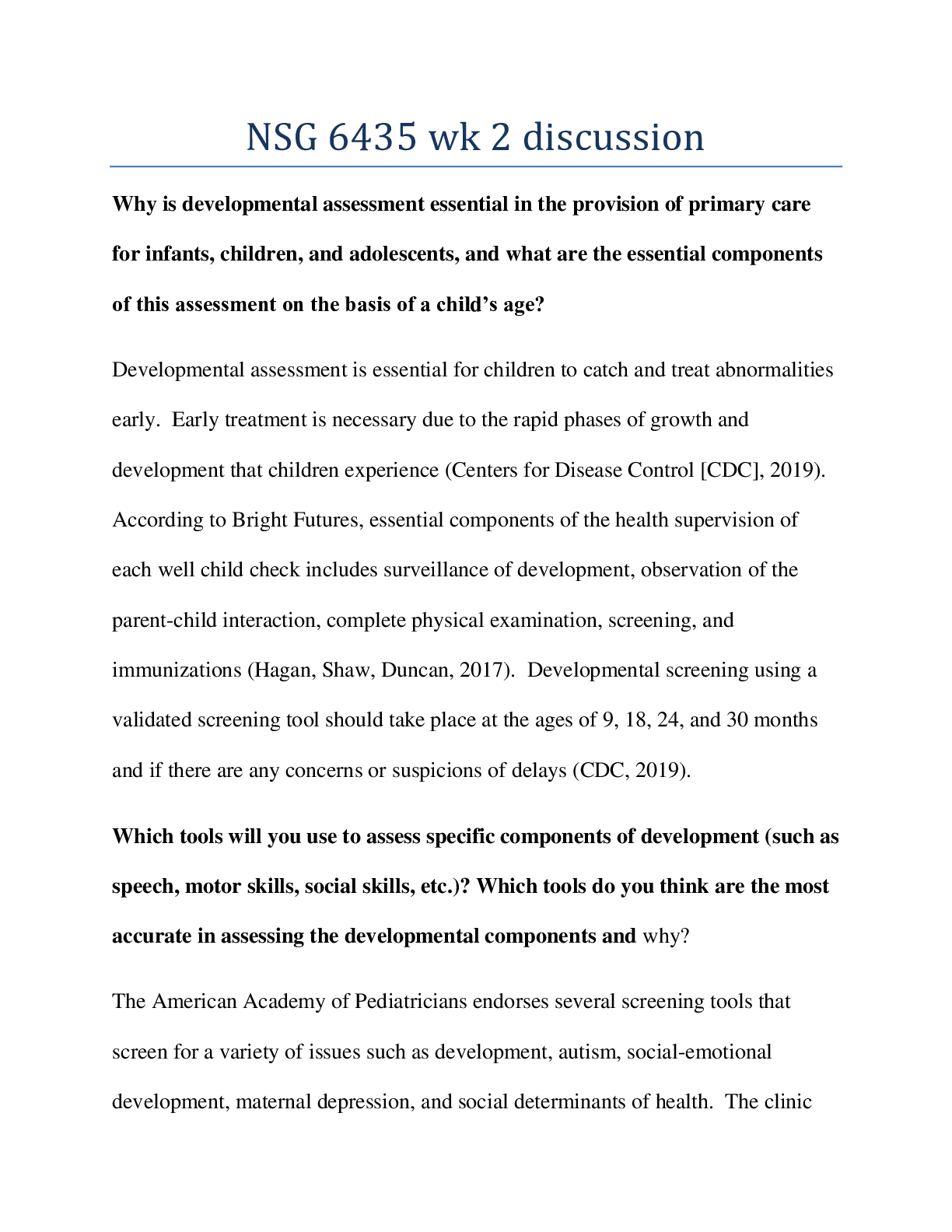
.png)
.png)
.png)

.png)


.png)
.png)
.png)






